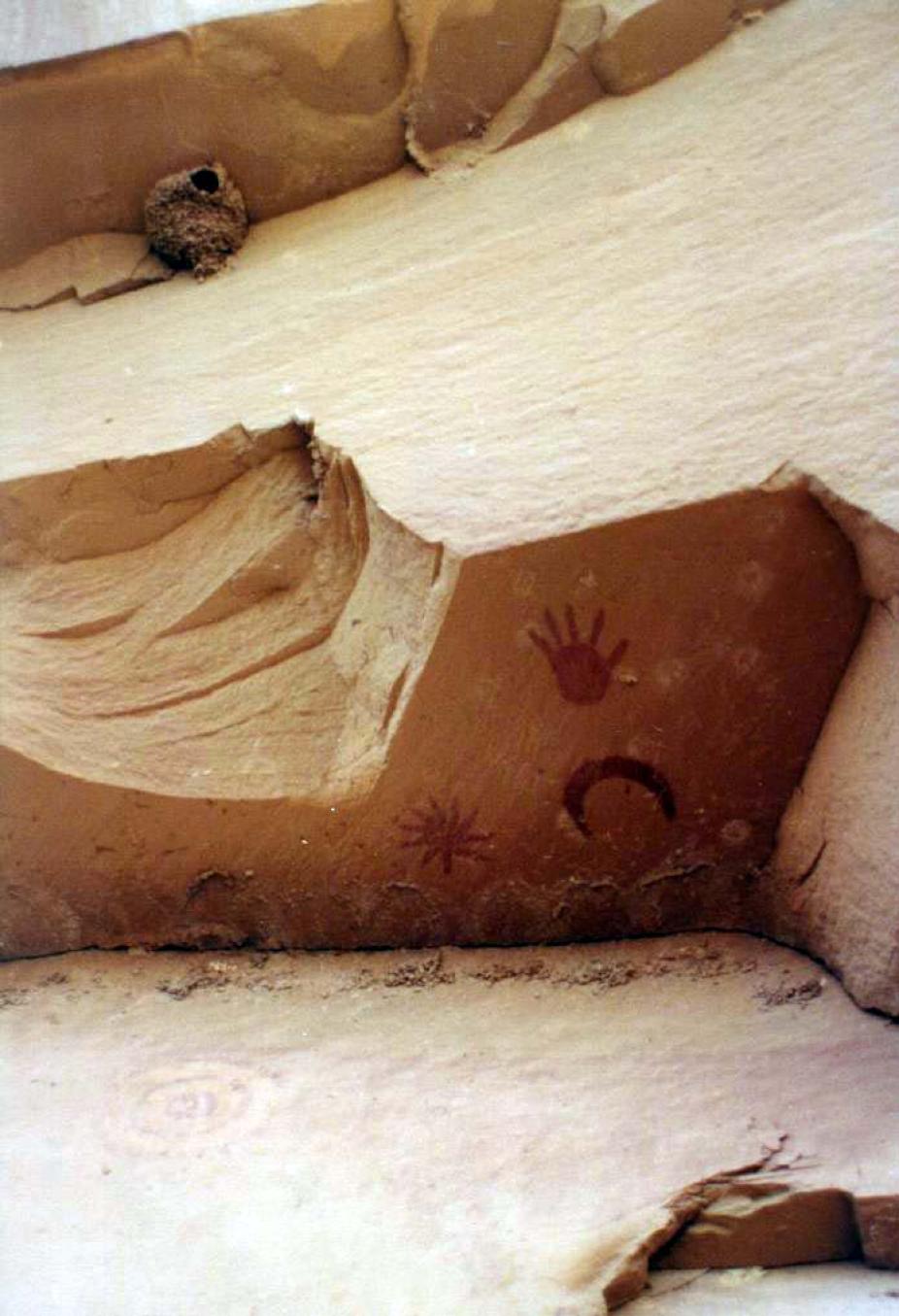Supernova Pictograph
A pictograph, associated with the Ancestral Puebloan culture found in Chaco Canyon, may depict a supernova that was first observed on July 4, 1054 A.D. The remnant of this supernova, which consists of debris ejected during the explosion, is known as the Crab Nebula and is located in the constellation Taurus. The supernova was visible in broad daylight, having reached a maximum brightness about ten times that of Venus, the brightest astronomical object visible from Earth besides the Sun and Moon. It remained visible by day for 23 days, and by night for 653 days. Observational accounts of this spectacular phenomenon have been found in both Chinese and Japanese records. Curiously, only two brief reports are known from medieval Europe.

Supernova pictograph panel contains three symbols: a large star (supernova), a crescent moon, and a hand print.
The pictograph was painted on a horizontal overhang six meters off the ground, located on an East-facing cliff face five hundred meters Northeast of the ruin Peñnasco Blanco. Strong circumstantial evidence points to the pictograph being a depiction of the supernova. The crescent is the moon, the star shape to the left the supernova, and a life-size hand print is taken to indicate that the site is sacred. Calculations of the Moon's orbit back to July 5, 1054 have shown that the moon was waning, just entering first quarter. These calculations also indicate that at dawn on July 5, 1054 in the American Southwest, the moon was within 3 degrees of the supernova, and its crescent oriented as on the pictograph (provided the pictograph is viewed looking up with one's back to the cliff, as the authors of the pictograph most likely did). With the apparent width of the moon being about half a degree, this pictograph comes basically as close as it possibly could to being a true scale rendition of the 1054 supernova seen in conjunction with the waning moon.
On the nearly vertical cliff face below the supernova a Sun-symbol can be seen, painted in pale yellow over a much faded red background. This, combined with a clear view on the mesa top to an eastern horizon suitable for calendrical purposes, might well indicate that the site was also a solar-observing station. From there, the Peñasco Blanco Sun-priest perhaps first noticed the supernova prior to a sunrise observation. Given how rare such an event must have been, it is then conceivable that he might have wanted to record the event. Over a dozen other examples of rock art possibly representing supernova 1054 (i.e., bright "star" close to a crescent Moon) can be found throughout the Southwest, but few are as astronomically convincing as this pictograph.
Very few probable non-solar astronomical records are found in the rock art of Chaco Canyon. This is somewhat peculiar, because the eleventh century, during which the Chaco Phenomenon reached its peak, saw quite a few unusual astronomical events: the 1054 supernova, the 1066 passage of Halley's comet, starting around 1077 numerous large sunspots visible to the naked-eye (reported in Chinese records), as well as the total solar eclipse mentioned previously (July 11, 1097). It then becomes tempting to look for other possible records of unusual astronomical phenomena. Scrutiny of the Sun-symbol reveals that the faded red pigment over which the symbol is painted extends to the right, in a manner that to the modern and astronomically inclined eye is suggestive of a comet tail. Could this be a record of Halley's comet? It is certainly a plausible hypothesis; but as with most astronomical sites and devices described in this slide set, it is likely to remain a conjecture.